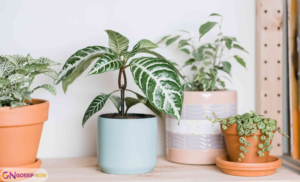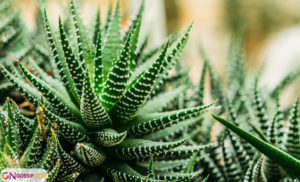The zebra plant, also known as Aphelandra zebra, is a striking succulent that adds beauty to any space with its unique foliage. Its bold, dark green leaves with light, creamy white stripes resemble a zebra’s pattern, making it a popular choice for houseplant enthusiasts. Whether you’re a seasoned plant parent or a beginner, this guide will provide you with all the essential information about zebra_plant care, propagation, flowering, and benefits.
In this article, we will explore everything you need to know about zebra plant, from choosing the right environment to ensuring they thrive in your home.
What is a Zebra Plant?
 The zebra_plant, or Aphelandra zebra, belongs to the Acanthaceae family and is native to the tropical regions of Brazil. Known for its stunning, striped leaves, the zebra_plant adds a touch of exotic flair to indoor spaces. Though technically a tropical plant, it is often referred to as a succulent due to its thick, fleshy leaves, which store water. Unlike typical succulents, the zebra_plant has distinct growth habits and requires slightly more care and attention.
The zebra_plant, or Aphelandra zebra, belongs to the Acanthaceae family and is native to the tropical regions of Brazil. Known for its stunning, striped leaves, the zebra_plant adds a touch of exotic flair to indoor spaces. Though technically a tropical plant, it is often referred to as a succulent due to its thick, fleshy leaves, which store water. Unlike typical succulents, the zebra_plant has distinct growth habits and requires slightly more care and attention.
Zebra Plant Care: How to Keep Your Zebra Plant Healthy
Taking care of a zebra_plant requires understanding its specific needs. Follow these care tips to ensure your zebra plant flourishes in your home.
Light Requirements for Zebra Plant
Zebra_plants thrive in bright, indirect light. Direct sunlight can scorch their leaves, leaving unsightly brown spots. Place your zebra_plant near a window with sheer curtains or in a well-lit room that receives indirect sunlight. While zebra_plants can tolerate some shade, their growth may slow down, and the beautiful stripes on the leaves may fade.
Watering Your Zebra Plant
Like most succulents, zebra_plants are sensitive to overwatering. The key is to allow the soil to dry out completely between waterings. Water the plant thoroughly but avoid letting it sit in water, as this can lead to root rot. In the winter months, you can reduce watering frequency, as the plant enters a dormancy period.
Soil for Zebra Plant
Zebra_plants prefer well-draining soil, so it’s essential to use a mix designed for succulents or cacti. You can make your own soil mix by combining regular potting soil with sand or perlite for added drainage. This ensures that excess water doesn’t collect at the roots, preventing root rot.
Temperature and Humidity
Zebra_plants prefer temperatures between 65°F and 75°F (18°C and 24°C). They can tolerate slightly cooler temperatures but should not be exposed to drafts or cold conditions. Zebra_plants also appreciate a bit of humidity, so placing a humidifier nearby or occasionally misting the leaves can help maintain the right environment.
How to Care for Zebra Plant Succulent Flower
Zebra_plants occasionally produce beautiful flowers, but they are known to flower less frequently than other plants. When they do bloom, the flowers are bright yellow, standing out against the dark green foliage. Here’s how to care for the zebra_plant to encourage flowering:
-
Ensure Adequate Light: Flowers usually appear in the spring or summer, so ensure your plant is getting enough indirect sunlight to support flowering.
-
Fertilize Regularly: Feed your zebra_plant with a balanced, water-soluble fertilizer once a month during the growing season. This helps provide the nutrients necessary for flower production.
-
Avoid Stress: Stress from temperature fluctuations, improper watering, or pest infestations can prevent the plant from flowering. Maintain a consistent care routine to encourage blooms.
Zebra Plant Propagation: How to Grow More Plants
Zebra_plant propagation is relatively easy if you follow the right steps. While zebra_plants don’t produce seeds as often, you can propagate them through cuttings. Here’s how:
-
Select a Healthy Stem: Choose a healthy, non-flowering stem from the plant.
-
Cut the Stem: Use clean, sharp scissors or pruning shears to cut a stem just below a leaf node.
-
Let the Cutting Callus: Allow the cutting to dry for a few hours or overnight, which will help the wound heal and prevent rot.
-
Plant the Cutting: Insert the cutting into a pot filled with well-draining succulent soil.
-
Water Sparingly: Mist the cutting lightly and ensure the soil remains slightly moist. After a few weeks, roots should begin to develop.
Common Issues with Zebra Plants and How to Solve Them
While zebra_plants are relatively easy to care for, they can encounter some issues. Here are a few common problems and how to address them:
-
Yellowing Leaves: This is usually a sign of overwatering or poor drainage. Ensure the plant is in well-draining soil and adjust your watering schedule accordingly.
-
Brown Leaf Tips: Dry air or inconsistent watering can cause the tips of the leaves to turn brown. Ensure your plant is in a humid environment and water it regularly.
-
Pests: Aphids, mealybugs, and spider mites can infest zebra plants. If you notice tiny webs or discolored leaves, treat your plant with insecticidal soap or neem oil.
Zebra Plant Benefits: Why You Should Own One
 Owning a zebra_plant not only adds beauty to your home but can also improve your indoor environment. Here are a few benefits of having a zebra_plant:
Owning a zebra_plant not only adds beauty to your home but can also improve your indoor environment. Here are a few benefits of having a zebra_plant:
-
Air Purification: Like many houseplants, zebra_plants help purify the air by absorbing toxins and releasing oxygen.
-
Stress Reduction: Studies have shown that having plants in your environment can reduce stress and improve overall well-being.
-
Aesthetic Appeal: The unique zebra-like stripes on the plant’s leaves make it a visually appealing addition to any indoor space, elevating the decor of your home.
Zebra Plant vs. Haworthia: What’s the Difference?
While both zebra_plants and Haworthia plants are succulents, they have distinct characteristics. Zebra_plants (Aphelandra zebra) have large, elongated leaves with white stripes, while Haworthia plants are smaller and have a more compact rosette form. Zebra_plants require slightly more attention when it comes to watering and temperature, while Haworthia plants are more tolerant of neglect.
Conclusion
The zebra_plant is a striking and rewarding succulent that, with the right care, can thrive and enhance the beauty of any space. From its unique, zebra-like striped leaves to its occasional yellow flowers, it offers both aesthetic appeal and numerous benefits, including air purification and stress reduction. By providing proper lighting, soil, watering, and humidity, you can ensure your zebra_plant remains healthy and vibrant.
Additionally, propagation through stem cuttings allows you to expand your collection or share this lovely plant with friends. Whether you’re a beginner or an experienced plant lover, zebra_plant care is simple yet rewarding. By following the tips outlined in this guide, you’ll enjoy the beauty and benefits of the zebra_plant for years to come.
FAQs
1. How often should I water my zebra plant?
Water your zebra_plant when the top inch of soil feels dry to the touch. Make sure not to overwater, as this can lead to root rot.
2. Can zebra plants tolerate direct sunlight?
No, zebra_plants prefer bright, indirect sunlight. Direct sunlight can scorch their leaves and cause damage.
3. How can I propagate a zebra plant?
Zebra_plants can be propagated by taking stem cuttings, allowing them to callus, and then planting them in well-draining soil.
4.What are the benefits of owning a zebra plant?
Zebra_plants purify the air, reduce stress, and add aesthetic value to your home with their striking foliage.
5.Why are the leaves of my zebra plant turning yellow?
Yellowing leaves may indicate overwatering. Ensure that the plant is in well-draining soil and adjust your watering habits.






